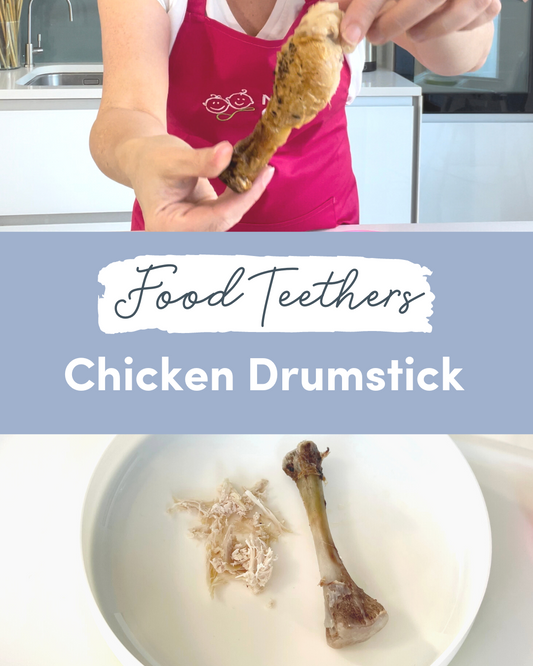Starting to Wean
Moving your baby onto solid food can be a bewildering experience. It takes a little time for them to learn to take food from a spoon and then figure out how to move it from the front of the tongue to the back of the mouth. Introducing solids may cause your baby to gag, spit the food out or cry because the food is not coming fast enough. I always recommend to start weaning from 5 ½ months. This will give your little one time to get used to the idea of food before they are introduced to a wider variety from 6 months onward.
Signs your baby is ready
- They sit up well without support.
- The start to demand feeds more often and it seems like milk alone is not enough to sustain them.
- They start to wake up during the night to feed having previously slept through the night.
- They have lost their tongue-thrust reflex and no longer push solids out of their mouth.
- They start to eye up your food at mealtimes and seem keen to try food.
Remember, babies can vary in terms of how long it takes to accept solids. Some will accept them straight away while others may take several weeks.
Portioning and Meal Plan
Our tips below are based on weaning from 5 ½ months. The idea is that you start to introduce solids to your baby slowly and build up to 3 meals a day by the time your baby is 6 months old.
For a FREE download of our detailed portion guide, sign up to our Mummy Cooks Club. It provides a clear breakdown of how many meals a day to offer, how to adapt the texture of food for your baby's age and when to introduce key food groups e.g. gluten, grains and meat.
How to Start Weaning
DAYS 1-3: Meal 1
Introduce your baby's first meal at a time they are most content. They shouldn't be too hungry as this is just a taste. I suggest midday as you can offer your baby their milk at 11am and then give them their solid food between 12 and 12:30pm.
Offer a root vegetable purée, making sure the texture is runny. Start off with a 4-6 Month Weaning Pot portion size - ensuring that if you start before six months you have not affected their milk intake.

DAYS 4-6: Meal 1 + Meal 2
After about 3 days, and if you feel your baby has taken well to the first few tastes, move onto adding in a second daily meal. This will be a breakfast meal and again should only be a taste in a 4-6 Month Weaning Pot. The texture should still be runny but you can also introduce ripe fruit purées.
DAYS 7-14: Meal 1 + Meal 2 + Meal 3
After the first week, you should introduce a third meal of the day for your baby in the evening at about 5pm after giving them an afternoon milk feed at 3pm. Continue with 4-6 Month Weaning Pots and start offering a range of mixed purées.
FROM SIX MONTHS:
At this stage, you should have established a good eating pattern with three meals per day along with baby’s milk.
You should now gradually increase texture and add finger foods. Your baby's portion sizes should also increase from 6-12 months. My portion guide to get a clear breakdown of how to do this - get it FREE with my Starter Weaning Set or sign up to the Mummy Cooks Club for a FREE download of it.
Tips for Weaning
- Including two 1oz (30g) servings of oily fish in an infant’s weekly diet from about 7 months will help meet their requirements of omega-3 which can boost brain development.
- Introducing lumpy foods from about 9 months is important and helps to develop an acceptance for a wider variety of foods later on. It can also boost their ability to speak and chew.
- Never avoid foods due to a suspected allergen or intolerance*. This can lead to a poor intake of nutrients and may make your baby more likely to develop fussy eating habits later on.
- Avoid staying too long at any particular stage of weaning. Don’t get caught up by batch cooking too much at a particular stage as the texture may not be relevant at a later stage. Instead freeze foods unblended as you can then adapt them for the stage your baby is at when you are feeding them.
- Introduce new textures and flavours (at recommended times) at a pace your child is comfortable with. Make sure to keep moving forward in your weaning journey, introduce variety in your child’s diet to avoid a fussy eater later on!
*All allergies need to be diagnosed by a doctor. If an infant does have an allergy or intolerance to a certain food, see a dietitian to make sure their diet contains the necessary foods for healthy development.
Remember, it's important to give your baby control when weaning so that they have a positive experience!

Our Weaning Advice page provides information and advice on weaning your baby. It includes recipes, tips, and articles on a variety of topics related to weaning, such as introducing finger food, adding herbs and spices to baby food, and healthy snacks for your baby, and lots more















